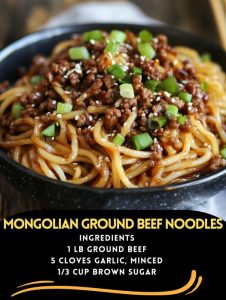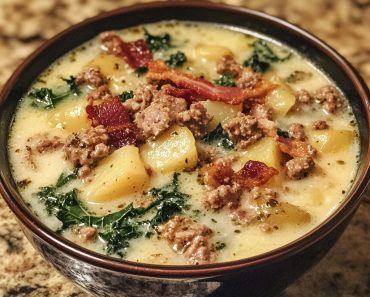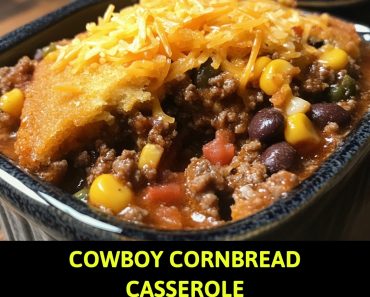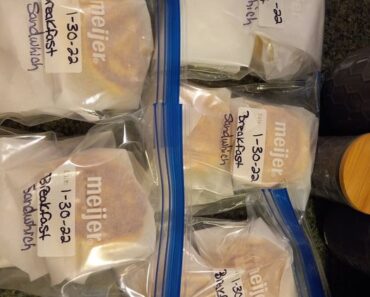
Mongolian Ground Beef Noodles
Imagine a dish that combines the savory flavors of Mongolian cuisine with the comforting familiarity of a noodle bowl—enter Mongolian Ground Beef Noodles. This delightful recipe brings together tender ground beef, rich and tangy sauces, and perfectly cooked linguine, all in one pan for an incredibly satisfying meal. Ideal for a quick weeknight dinner or a cozy weekend meal, this dish is packed with bold flavors that balance sweetness, saltiness, and a hint of spice. It’s a meal that is both heartwarming and easy to prepare, perfect for those days when you crave something deliciously comforting without spending hours in the kitchen.
Ingredients Overview
- Ground Beef (1 lb): Provides a hearty base for the dish, bringing in rich, meaty flavors that complement the sweet and savory sauce.
- Garlic (5 cloves, minced): Fresh garlic adds a robust, aromatic flavor that pairs wonderfully with the savory beef and the sweet elements of the sauce.
- Brown Sugar (1/3 cup): Adds a hint of sweetness to the dish, balancing the salty soy sauce and the umami-rich hoisin sauce.
- Beef Broth (1/4 cup): Enhances the savory flavor and adds moisture to the sauce, making it rich and flavorful.
- Soy Sauce (1/3 cup): A staple in Asian cooking, soy sauce provides the salty, umami base for the sauce.
- Hoisin Sauce (3 tablespoons): Adds depth with its sweet and salty profile, perfect for creating a rich, complex sauce.
- Ground Ginger (1/2 teaspoon): Offers a warm, slightly spicy undertone that complements the garlic and other spices.
- Ground Black Pepper (1/2 teaspoon): Adds a subtle heat and enhances the overall flavor of the dish.
- Red Pepper Flakes (Pinch, optional): For those who like a bit of heat, a pinch of red pepper flakes brings a mild spiciness.
- Linguine (10 oz): The pasta base for this dish, linguine is thick enough to hold onto the rich, flavorful sauce.
- Cornstarch (1 tablespoon): Used as a thickening agent to give the sauce a silky texture that coats the noodles beautifully.
- Water (2 tablespoons): Mixed with cornstarch to create a slurry that thickens the sauce.
- Green Onions (4, sliced): Fresh, crisp, and slightly spicy, green onions add a burst of color and flavor to the finished dish.
Step-by-Step Cooking Instructions
1. Prepare the Pasta
Boil the Pasta:
Bring a large pot of salted water to a boil. Add the linguine and cook according to the package instructions until it reaches al dente perfection—firm to the bite yet tender.
Drain and Set Aside:
Once cooked, drain the pasta in a colander and set it aside. This will allow it to cool slightly and prevent overcooking as you prepare the rest of the dish.
2. Cook the Ground Beef
Brown the Beef:
In a large skillet over medium-high heat, add the ground beef. Cook, breaking it apart with a wooden spoon, until it is no longer pink.
Drain Excess Fat:
If there is excess fat in the skillet, carefully drain it off to ensure the dish isn’t too greasy. Leave a small amount of fat to cook the garlic and build the sauce.
3. Add Aromatics and Build the Sauce
Sauté the Garlic:
Add the minced garlic to the skillet with the browned beef. Stir and cook for about 1 minute, or until the garlic becomes fragrant. Be careful not to burn it, as garlic can quickly become bitter.
Combine the Sauces and Spices:
Pour in the soy sauce, beef broth, brown sugar, hoisin sauce, ground ginger, ground black pepper, and a pinch of red pepper flakes if desired. Stir well to combine all the ingredients. Let the mixture simmer for 2-3 minutes to meld the flavors.
4. Thicken the Sauce
Make the Cornstarch Slurry:
In a small bowl, dissolve the cornstarch in 2 tablespoons of cold water to create a slurry. This will help thicken the sauce without clumping.
Thicken the Sauce:
Pour the slurry into the skillet with the beef and sauce mixture. Stir continuously as the sauce begins to thicken, turning it into a luscious, glossy coating.
5. Combine the Noodles and Serve
Add the Linguine to the Sauce:
Add the cooked linguine back into the skillet. Gently toss the noodles in the sauce until they are well coated, and let them sit for 2-3 minutes to absorb the flavors.
Top with Green Onions and Serve:
Sprinkle the sliced green onions over the top for a fresh, vibrant finish. Serve hot and enjoy the rich, savory, and slightly sweet flavors of this comforting dish.
Valuable Tips for a Seamless Cooking Experience
- Use Fresh Ingredients: Fresh garlic and ginger elevate the flavors of the dish significantly. While ground ginger works in a pinch, freshly grated ginger adds a more vibrant and spicy note.
- Don’t Overcook the Pasta: Make sure to cook the pasta al dente, as it will continue to cook slightly when combined with the hot sauce.
- Control the Heat: Adjust the amount of red pepper flakes based on your spice preference. You can also omit it altogether for a milder dish.
- Perfect the Sauce Consistency: If your sauce is too thick, add a bit more beef broth or water to reach your desired consistency.
- Garnish Generously: Green onions not only add a pop of color but also a fresh, crunchy element that balances the rich sauce. Feel free to add more as desired.
Storage and Reheating Tips
- Storage: Store any leftovers in an airtight container in the refrigerator for up to 3 days.
- Reheating: Reheat gently in a skillet over medium heat, adding a splash of water or beef broth to loosen the sauce. Alternatively, microwave on medium power in 1-minute intervals, stirring in between until warmed through.
- Freezing: This dish can be frozen for up to 2 months. Freeze in individual portions for easy reheating. Thaw in the refrigerator overnight before reheating as directed above.
Frequently Asked Questions (FAQs)
1. Can I use a different type of pasta?
Yes! While linguine is great for this recipe, you can use spaghetti, fettuccine, or even a short pasta like penne or rigatoni.
2. Can I substitute ground turkey for beef?
Absolutely! Ground turkey or chicken works well and is a leaner option.
3. What if I don’t have hoisin sauce?
You can substitute hoisin sauce with a mixture of soy sauce, peanut butter, honey, and a bit of vinegar for a similar flavor profile.
4. Is there a gluten-free option for this recipe?
Yes, simply use gluten-free pasta and a gluten-free soy sauce alternative like tamari.
5. Can I add vegetables to this dish?
Definitely! Sliced bell peppers, snap peas, or broccoli would make great additions.
6. How do I prevent the garlic from burning?
Cook the garlic on medium heat and keep stirring. It only needs about a minute to become fragrant.
7. Can I make this dish vegetarian?
Yes, substitute the ground beef with plant-based crumbles and use vegetable broth instead of beef broth.
8. What can I use instead of cornstarch?
Arrowroot powder or all-purpose flour can be used as a thickening agent instead of cornstarch.
9. Can I make this dish ahead of time?
Yes, prepare the sauce and cook the pasta ahead of time. Combine and heat through just before serving.
10. How can I make this dish spicier?
Add extra red pepper flakes or a splash of sriracha to the sauce for more heat.
11. Can I double this recipe?
Absolutely, just make sure your skillet or pan is large enough to accommodate the extra volume.
12. Can I use a different meat?
Ground pork or lamb could be an interesting twist to the dish, providing a different flavor profile.
13. Is there a low-sodium version of this recipe?
Use low-sodium soy sauce and beef broth to reduce the sodium content.
14. How do I keep the noodles from sticking together?
Toss the drained pasta in a bit of olive oil to prevent sticking if it sits for a while.
15. What other garnishes would go well with this dish?
Sesame seeds or a sprinkle of crushed peanuts can add extra texture and flavor.
16. Can I use fresh ginger instead of ground ginger?
Yes, fresh ginger provides a more intense flavor; use about a 1-inch piece, grated.
17. How do I adjust the sweetness of the sauce?
Reduce the amount of brown sugar for a less sweet sauce or add a bit more if you prefer it sweeter.
18. What kind of beef broth should I use?
A low-sodium or no-salt-added broth allows you to better control the dish’s seasoning.
19. Can I add mushrooms?
Yes, sautéed mushrooms would add an earthy flavor and more texture.
20. How do I know when the sauce is thick enough?
The sauce should be thick enough to coat the back of a spoon. If it runs off too quickly




















